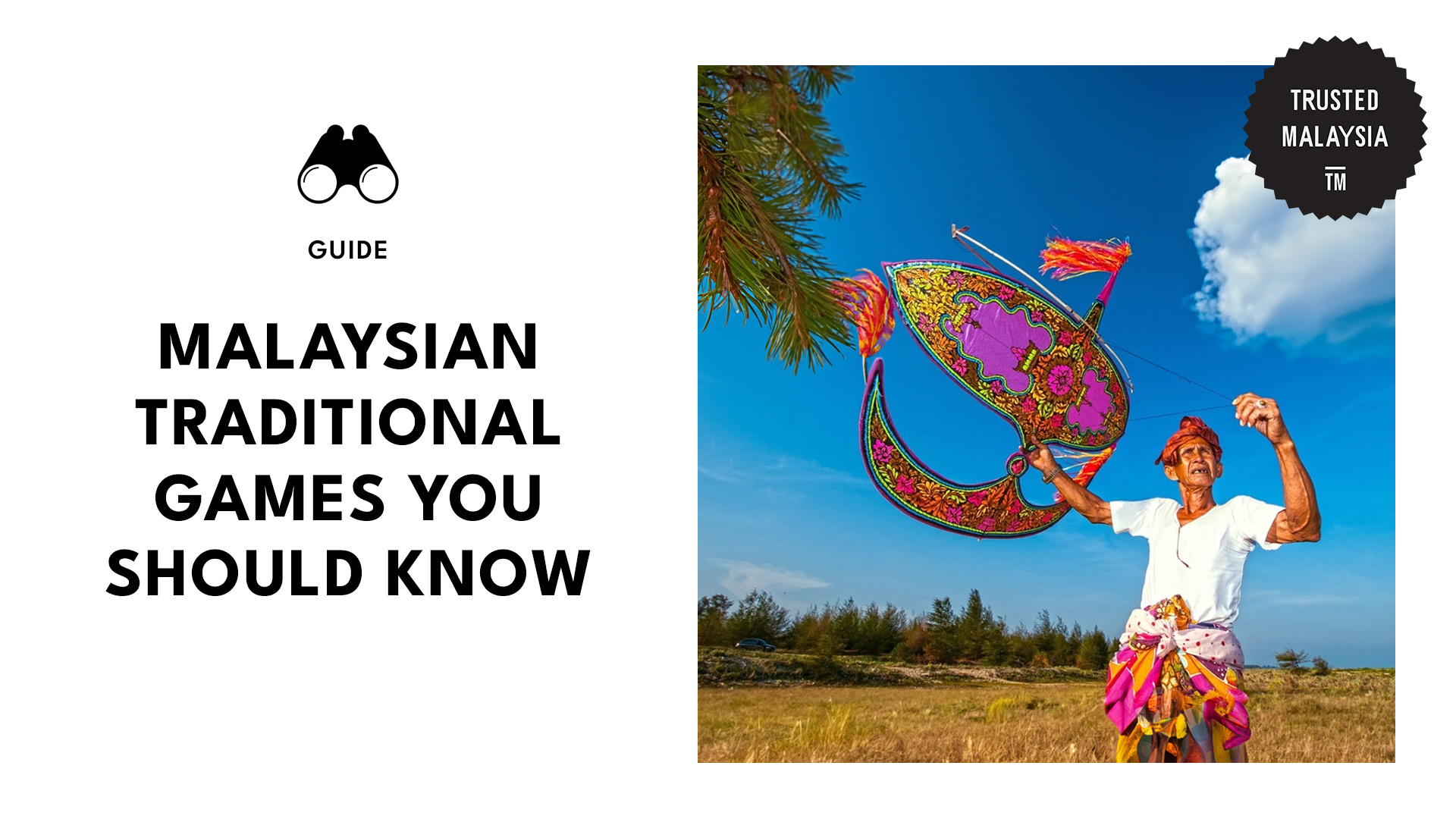Malaysia’s Top 10 Traditional Games (So Awesome, You’ll Have Fun Even without WiFi!)
So listen, I’ve got some tales to spin—though, this time, it’s not about my latest online shopping fiasco or a tragic attempt at a TikTok dance challenge. No, today we’re diving deep into a universe far, far away from WiFi signals and phone notifications.
I’m talking about the magical realm of traditional Malaysian games. Now, hold up before you yawn and scroll away, ’cause these games are so entertaining that they made me forget about the internet for like an hour or two (but really, I could play them all day!).
In fact, playing these games might just be the digital detox you didn’t know you needed. You think I’m exaggerating? Well, then see it for yourself and read on!
Congkak

Congkak is that game with a long wooden board that looks kinda like a boat, filled with holes and filled with marbles or seeds. This thing’s an old-school classic in Malaysia and has been around for ages.
It’s usually played by two people who sit opposite each other, with the objective of collecting as many marbles in your ‘storehouse’ as possible. It’s kind of like a mental workout because you’ve got to strategize your moves ahead of time.
It’s not just randomly dropping seeds into holes; nah, there’s a whole lot of thinking involved. Also, it’s pretty cool because it teaches math and strategy without feeling like a classroom lesson.
Pro tip: If you plan on playing, make sure you double-check the number of seeds or marbles in each hole to make sure it’s even. You don’t want to start off on the wrong foot with an unfair advantage.
Sepak Takraw

Sepak Takraw is essentially volleyball, but with a twist: instead of using hands, players kick a rattan ball over a net. It’s super popular in Southeast Asia, and watching it is just as fun as playing.
You need three players on each team, and let me tell you, the level of flexibility and agility required is unreal. Players pull off these acrobatic kicks and flips that’ll make your jaw drop!
The game started out centuries ago, believe it or not, and now it’s even got official rules and international competitions. Plus, it’s a great team sport, so it’s perfect for making friends or just having a good time with your current buddies.
Pro tip: Stretch, stretch, and stretch some more before you even think about playing. The last thing you want is to pull a muscle trying to imitate those cool moves.
And wear comfortable clothes because you’ll be moving a lot.
Batu Seremban

Batu Seremban is deceptively simple but totally addictive. Originally, it was played using five small stones, but people use bean bags or seeds these days.
It’s mostly a solo game, but you can take turns to see who scores the highest. The goal is to throw and catch the stones in various patterns, and it gets trickier with each level.
This game is super portable; you can play pretty much anywhere. And here’s a fun fact: it’s said to originate from ancient times when folks had to be creative and use whatever materials they had on hand for entertainment.
Pro tip: Practicing on a soft surface like grass is a good idea, especially if you’re using actual stones. Dropping them won’t hurt as much, both physically and emotionally, as it would on a harder surface.
Bottle caps

Now, let’s chat about playing with bottle caps. Yep, you heard that right. Before the era of digital games, kids used to collect these shiny caps from soda, beer or water bottles and create whole games out of them.
It could be anything from simple flicking games, where the objective is to hit a target, to more elaborate setups like mini-golf courses created from everyday items. The cool part is how creative you can get with it.
Plus, you’ll also participate in sustainability, so you just need a bunch of caps, and you’re good to go. This game is super flexible in terms of players—go solo, pair up, or get a whole gang involved.
Pro tip: If you’re collecting caps, try to get a variety because different sizes and materials can add an interesting challenge to the game. Just make sure to smooth out any sharp edges to avoid any cap-related casualties.
Guli (marbles)

Guli, or marbles, as it’s more commonly known, is all about shooting small glass balls to hit other marbles out of a designated area or into a hole. It’s played worldwide, but each place has its own twist on the rules.
In Malaysia, it’s not just a casual pastime; it’s a competitive sport. You can play it in two modes: ‘Langgar,’ where the goal is to hit your opponents’ marbles out of the circle, or ‘Templek,’ where you aim to get your marble to stop touching others.
It sounds simple, but there’s a surprising amount of skill and strategy involved. And you’ll need at least two players, but more can join for a bigger challenge.
Pro tip: Picking the right marble can make all the difference. Heavier marbles are great for hitting, but lighter ones are better for target shooting.
Gasing

Gasing are not your average spinning tops; they’re massive, elaborately decorated, and a big deal in Malaysia. To get these bad boys spinning, it takes skill, strength, and a whole lot of practice.
Competitions are fierce, with the goal being to see who’s Gasing can spin the longest or who can knock the opponent’s out of the ring. It typically involves two players but can vary depending on the version of the version of the game you’re playing.
The making of these tops is an art form in itself; they are usually crafted from hardwood and can be quite a collector’s item. Moreover, they say it originated as a way to give thanks for good harvests, so there’s a bit of history thrown in too.
Pro tip: Before you dive in, know that launching a Gasing requires a specific technique—it’s all in the wrist and arm. Watching a veteran player or a tutorial before giving it a shot can save you some embarrassment and, probably, a sore arm.
Ceper

Ceper is like the older sibling of marbles, with an extra pinch of strategy. Each player gets three disks (it could be metal washers or anything similar), and the aim is to throw them into a hole or as close as possible while knocking your opponents’ disks away.
Think of it as a mix of marbles and golf, but on a much smaller scale. You can play Ceper with two people or in teams, making it super versatile.
It’s all about precision and sometimes just how lucky you are with your throw. And yes, like many traditional games, it’s more than just fun; it’s about improving your hand-eye coordination on the DL.
Pro tip: The terrain plays a big role in your strategy since a rough surface can totally change the game. Scouting out the playing area before starting and adjusting your throwing technique can be the difference between winning and losing.
Galah Panjang

Galah Panjang might sound fancy, but it’s essentially a Malaysian tag on steroids. It’s played on a rectangular field with lines that players can’t cross.
Now, the aim for the attacking team (“runners”) is to get from one end to the other and back without being tagged by the defenders. This game requires a minimum of ten people to play, making it the ultimate game for large groups or family gatherings.
It’s hectic, it’s fun, and it will definitely get your heart pumping. Plus, it’s a great way to teach teamwork and strategy, as players need to work together to outmaneuver the defenders.
Pro tip: Speed is crucial in this game, but so is being sneaky. Sometimes the best way to cross the field is by distracting the defenders and making a run for it when they least expect it.
Wau Bulan

Now, Wau Bulan is not so much about playing; it’s about flying. And not just any kite—it’s a legit cultural icon of Malaysia, right up there with the hibiscus.
Heck, it’s even got its spot on the reverse side of the fifty-cent coin, showcasing its intricate design and that signature hummer on top. Now, they’re huge, with elaborate designs and a bow shape that makes a humming noise when they catch the wind.
Flying them is a popular pastime, especially on the east coast of Malaysia. Kite flying competitions are actually a thing here, with judges scoring on design, flight stability, and the Wau’s ability to stay aloft.
Pro tip: If you’re trying this out, remember that it’s all about the wind. Too little, and your Wau won’t go anywhere, while too much, and you risk losing control.
So you better check the weather forecast before heading out to make sure conditions are just right.
Teng-Teng

Teng-Teng is what happens when hopscotch meets extreme skipping. It’s a game that requires nothing but a bit of space and some serious hopscotch skills.
It’s played by hopping on one foot into squares drawn on the ground while avoiding certain spots. It’s simple yet surprisingly challenging.
You can play Teng-Teng solo, but it’s better with friends, taking turns to see who can complete the sequence without mistakes. Plus, drawing out the squares can be a mini art session before the game even starts.
Pro tip: The right footwear can make or break your Teng-Teng game. Slippery soles or clunky shoes will only lead to disaster. Opt for something comfortable that grips well to the ground to keep you stable and hopping with ease.

